
|   |

|   |
 e-mail: leelakaverivenkat@gmail.com Nirikshana: Natya Kala Conference marks its 39th year of celebration-2 Photos courtesy: NKC 2019 January 13, 2020 Nirikshana: Natya Kala Conference marks its 39th year of celebration-1 Traditional seen in new ways 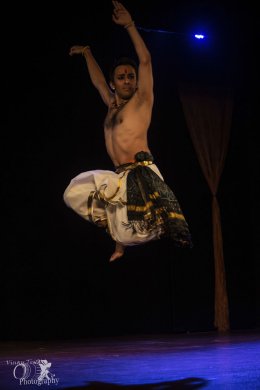 Christopher Guruswamy 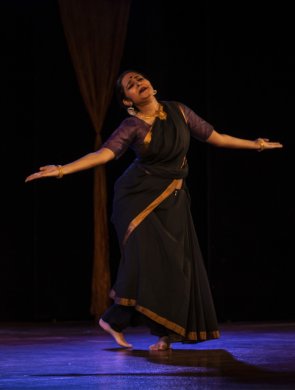 Preeti Ramaprasad 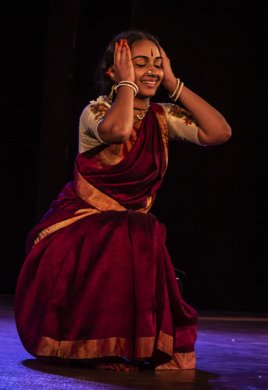 Harinie Jeevitha 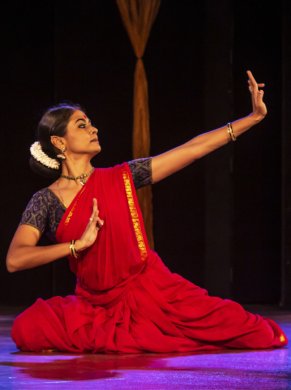 Radhe Jaggi
(Photos: Vinay Tiwari)
Alarippu Adventures was an exciting session offering an excellent example of youngsters pushing the creative envelope with discoveries, egged on by their unbound curiosity. And they have found an excellent fellow traveller in Ramamoorthy Ganesh, the mridangist, who provided the ideal rhythmic arithmetical springboard. The Alarippu has within its rhythmic frame the versatility of accommodating different ideas in different nadais and talas, with a few like the Mayur Alarippu already known. Preeti Ramaprasad made it the Navarasa Alarippu, with the nine emotions. Christopher Guruswamy's Misrajati chemba talam Alarippu was based on Garuda, the choreography influenced by what he saw in the Ram Gopal Dance Museum in Indonesia and Rukmini Devi's Jatayu Moksham in the Ramayana Series. The ' Dhit Tam' with the eyes of the Garuda looking hither and thither and the arms in a wide wing spread were very fitting. Harinie Jeevitha's Nritta Keli wherein she showed different games in Alarippu in chatusrajati dhruva talam, was another fine effort. Radhe Jaggi in a khanda jati Alarippu drew the outlines of a temple with entrance, gopuram and sannadhi. It is the working of the various minds which was very invigorating to behold! Ensemble work 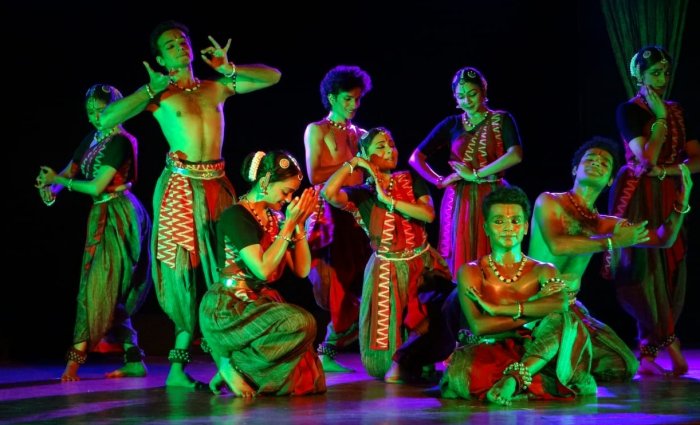 Spanda ensemble (photo: Varun Khanna) 'Nokkam' by Leela Samson's Spanda ensemble began with an invocation to 'Bhaskaraya,' the Sun presiding over Earth, Water and Akash with music by Rajkumar Bharti using the ragas Suryakanti, Ravichandrika and Surya with Beejaksharas built into the sahitya, with dancers in a Surya Namaskar making for a fine start. The Jatiswaram in Shivakalyani was an expansion of movement for a group before going on to 'Nadiyin Neeti' which concerns man's totally insensitive neglect of a resource which is the boon of life. Varying moods of the flow of the river (in this case Jamuna) suit ensemble productions where the group has dancers who are individuals first and computerised sameness of movements cannot portray a river flowing. The ragamalika music had Vasantha, Simhendramadhyama, Kamas, Nagaswarawali and Ranjini. Sahitya and teermanams woven into it were by Rajkumar Bharati who also rendered the Jathis. Very poetic and weaving a philosophical theme like the Swing of Time into raga singing, was the item suggesting Dawn which sees the birth of new life to Dusk and Death, lovers veiling and unveiling and woman feeling new life beginning within her. 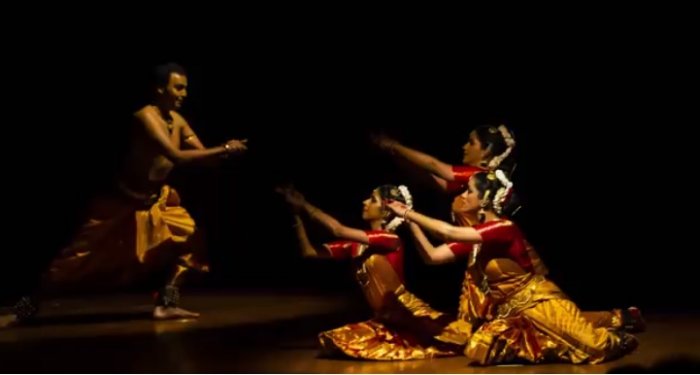 Vaibhav Arekar and group 'Nibandhana' by Vaibhav Arekar and Sankhya Dance Company was by far one of the best group expressions seen during the five day event. The familiar Margam format acquired a very different group dimension in Vaibhav's visualisation. The quest is the same but when multiple bodies are engaged in that one journey, to keep the destination in mind, without diluting the artistic vision is not easy. In keeping with the spiritual end, the start was with a Vachana of Basavanna "Ullavaru Shivalaya maduvaru nanenu madali badavanaiya." (The rich will build Shivalayas but what can I, a poor man, offer but this body). In the Kalyani Jatiswaram, the aesthetic formations were a delight - quite different from what one is treated to. The Bhairavi Varnam "Mohamana enmeedu" made for a true climax with three main nayikas simultaneously presenting three manifestations of the same statement, with multiple bodies presenting the teermanam links. Discarding the frontal view all the time, the dancers dispersed and came together in ever changing formations, with Vaibhav weaving his way through as a fleeting figure. A trend setter in how stage space is used, it was an intense experience of bhakti sringar over twenty minutes by the group, with Kartik Hebbar's bhav-filled singing, Kalishwaran Pillai's nattuvangam, and Dakshinamurthy Pillai's mridangam - the fine dancers preserving tautness of line and rhythm along with bhava. Vaibhav's feel for choreography being what it is, one never gets the feeling of the already seen in his work. In a reverse situation, it was the divine Krishna declaring his love for Radha in the ashtapadi "Priye charusheele." Vaibhav's solo depiction, was invested with a quality of silence and dignity even in the passionate surrender "Dehi pada pallavamudaram" when with back to the audience, Krishna lays his head down before the imagined Radha. It was a penitent Krishna not robbed of dignity as often seen! The group came together in the finale with Lalgudi Jayaraman's Tillana in Vibhas. 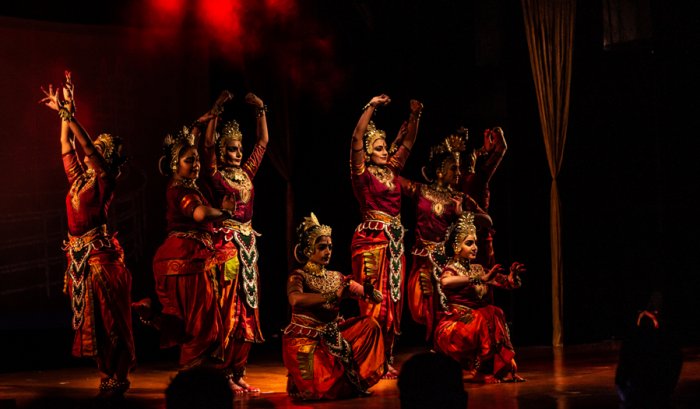 Anjasa (photo: Vinay Tiwari) 'Anjasa-Unravel the wonders of the Buddhist monuments of Asia' by Singapore based Apsaras Arts Dance Company was woven round the theme of Buddhism, Anjasa meaning path in Pali (spoken Sanskrit). In a sequel to 'The Beauty of Architecture,' Apsaras here explores the beauty of Buddhist temple architecture, taking the viewer on a journey through monuments including Nepal's Mahadevi temple, Bodh Gaya's Maha Bodhi temple, Sanchi Stupa in India, Vattadage in Sri Lanka, the Shwedagon temple in Rangoon, Bayon in Cambodia and Borobudur in Indonesia. While the relevant commentary on each site along with some line drawings and visuals seemed fine, the connection of the dances being rendered after each temple was introduced (and I am not referring to the quality of the Bharatanatyam) was not very clear. Contemporary Expressions in Bharatanatyam 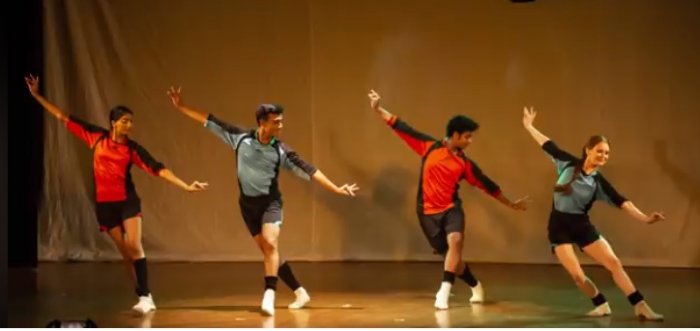 Shrishti, Nina Rajarani Dance Creations 'Play Ball,' a suite of three dance pieces by Shrishti, Nina Rajarani Dance Creations from UK, began with A Pining Lover in eternal waiting, caught amidst high energy and stillness of life, singer Yadavan's music with Tamil sahitya woven in as an intrinsic part of the performance showing young people at work and play - the brooding woman in the midst of activity all round soliloquising 'Is this love?' "Inivaruvai naan ariyen." (I don't think you will come again). The main piece 'Bend it' was based on a football match for which the metre, rhythm and music, after much pondering ultimately was found in Oothukadu Venkatasubbaiyer's 'Kalinga nartana' in Gambhira Nattai! So Krishna's triumphant dance on the hood of the snake was like a football match! The football moves were all part of the dance with a lot of nritta, and the sound track carrying even the hum of the crowd. With a new group of dancers recruited from India, the work still impressed. But the concluding work catching the fast pace of life in a city, met with very patchy under rehearsed performance. Another couple also based abroad, Savitha Sastry and A.K. Srikant in what was called 'Unchained: Odyssey of the Nouvelle Raconteurs' in which Bharatanatyam grace and technique were supposed to be married to original content away from religion, mythology or lore, in the excerpts shown, conveyed little and what was demonstrated by the students did not help make things clearer. Talk sessions too crowded to be in depth  Panel moderated by Akhila Krishnamurthy The important area of discussions, central to a conference, yielded very little beyond banalities. Too many participants squeezed into 45 to 50 minute sessions, with each being put a question by the moderator meant a constant attempt to say everything in a couple of minutes, with a constant eye on the time. Polite answers, (not one person had anything new to say) merely scratched the surface of perennial issues dogging thedance scene. The vital aspect of 'Dance Curation' saw Y.Prabhu, Sridhar Shanmugam, Harishankar Krishnaswami, Natarajan Ramji, Swapnokalpa Dasgupta, R.V.Raghavendra, Rajeswari Ramachandran being asked questions by Akhila Krishnamurthy on the important subject of how dancers were chosen by well known Sabhas or institutions, each of these panellists represented and headed. Ultimately what came across was that a clutch of people, who along with others in their organisations were the 'aye' and 'nay' sayers on what was 'auchitya' for a dance performance. While all these organisations by promoting events, were no doubt rendering yeoman service to the cause of dance, there was no space anywhere for the 'other' who thought differently. Very compartmentalised ideas of what is to be given encouragement and what needs to be kept out, have crept in over time. How do fresh ideas come in? And of course on the subject of 'pay and dance' which happens more often than not, nobody knew or said anything. 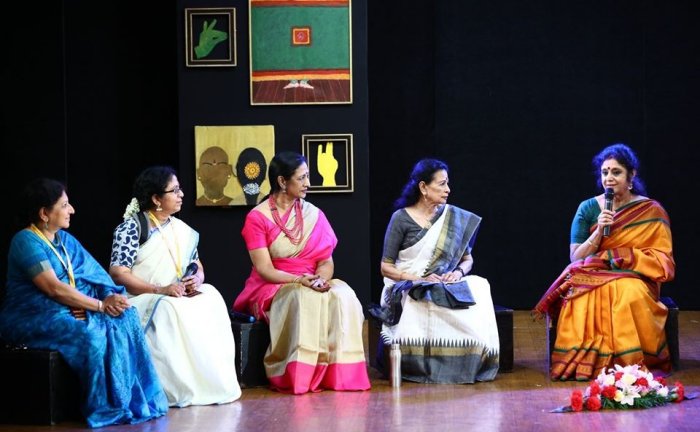 Panel moderated by Chitra Visweswaran 'Arangetram - Boon or Bane' had many dancer teachers, half the panel speaking for arangetram as a boon and the other half as bane. Rathna Kumar, settled in the United States, called arangetram a social statement about which every student was questioned by every writer and in a country where Indian dancers get few solo chances to perform, the arangetram becomes the one big event which students crave for. For Saroja Vaidyanathan even non-Tamil students get spurred by arangetram because it gives them an identification of a kind and a legitimacy as Bharatanatyam dancers. And it enthuses others too to do better in the class. For Leela Samson who was appalled at the kind of money splurged on an arangetram bhakti, shradha, humility, kshamata respect for Guru and mental preparedness could be instilled by the teacher in the class. Dancers have to be taught to be inclusive and not exclusive and it is the latter feel the arangetram seemed to bring about. Sheela Unnikrishnan recollected how her Kuchipudi guru Vempati Chinna Satyam, when he felt a student was good enough for a solo stage appearance, had a simple function at his own cost in the institution itself and that was it. Sujatha Ramalingam based in Kolkata said that her city knew very little about the arangetram culture. Meenakshi Chittaranjan wondered if the youngsters of today have the same commitment as they had in the past. In the Pandanallur tradition the arangetram was one of the necessary symbols of the beginning. The pain/pleasure, bitter/sweet thoughts associated with arangetram made it an oxymoron. In places like Kalakshetra and Nalanda older students were involved. Never easy handling gurus and musicians in an arangetram and done successfully one is ready to handle the son in law and sambandis! Padma Suresh mentioned her own arangetram being in a temple under Guru Kalyanasundaram. What did not come out was how teachers too had begun to regard the awards which came with an arangetram - making it a burden on the parents. For the well oiled, this has become yet another way of showing off their wealth. Embracing simplicity as a rule with emphasis on the dancer's prowess as the need of the hour was not underlined enough. Arangetram has become important for all the wrong reasons of being noticed by those who matter in the performance field. 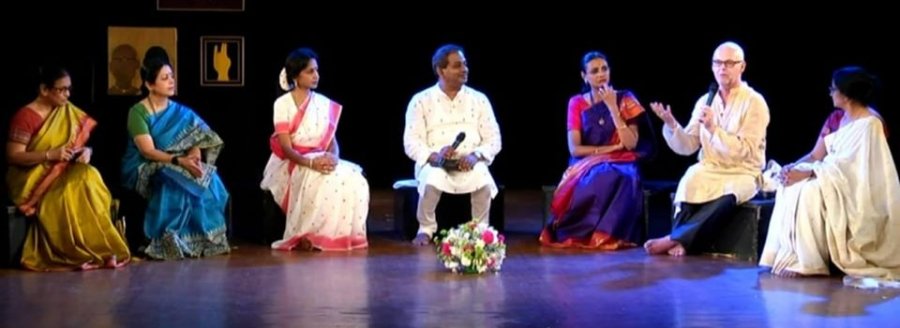 Panel moderated by Aravinth Kumarasamy (photo: Sunil Kothari) 'Guru Cool: A discussion on emerging trends in new age training' was for me a case of lost opportunity. So much could have been discussed about how training takes place today - about spoon feeding as training, about program bound teaching having lost the old integrated approach, with mothers waiting in bated breath for their dear ones, in all finery, to make a stage appearance. Aravinth Kumarasamy was the moderator. There was an important reference to Skype when speaking of teaching and use of technology (both bane and boon) by Urmila Satyanarayanan. She admitted that this was due to compelling reasons and also mentioned that the fraction of a lag in time before action registers (making touching the 'samam' less than perfect in split second timing) made her uneasy. She agreed that Skype can be an additional tool but the guru's live interaction could not be totally replaced. Priyadarsini Govind said that as a frequently performing artiste, she had very few students. She mentioned giving performance videos and music to students living abroad because they do not have easy access to music. But the point is that some students just clone what is given in a video and without the intervention of a guru (video as an additional help) this can be a double-edged sword. Bragha Bessel said that she followed her Guru Kalanidhi Narayanan's method and that link for her was important. Canadian Jai Govinda said that since teaching means opening the doors of his world to students, he too makes it a point to enter their worlds (far away from ishta devatas and temples and more influenced by Harry Potter) for without this two way process teaching cannot succeed. Sreelata Vinod made a very significant point that teachers have to update themselves instead of becoming too comfortable - which often happens. She and her organisation believe in reaching out to areas where people want to know, not just to dance, but how dance came about. Documenting each stage of the process of teaching is necessary. For Indira Kadambi, intense workshops (she provides residential facilities) where text, context, characterisation (her accent is on abhinaya) of a lyric are explained. Her husband teaches singing which is a very important part of learning Sabdams and Javalis. One has to ignite an interest and not encourage treating any lyric lightly. "I give an item and let them grow through it." She was emphatic about not giving them videos of the music. 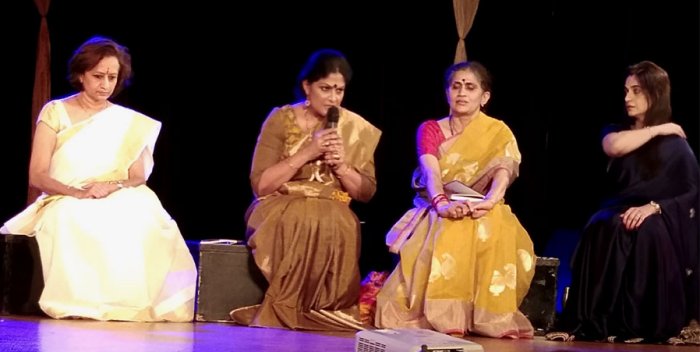 Panel moderated by Padmini Ravi (photo: Lalitha Venkat) 'Ensemble Narratives of Diverse Expression' had some good minds with Padmini Ravi as moderator. But again path breaking work cannot be just mentioned without deeper analysis of how the work was approached. Each producer showed some video material of two minute excerpts from path breaking programs. Shankar Kandasamy based in Kuala Lumpur mentioned Laya kavitai and randomness being introduced in what works to a system of order - Converge-Diverge. He spoke of multi dimensional Pushpanjali But all this needed more explanation. Similarly, when Sheejith Krishna spoke on his path breaking 'Don Quixote' in Bharatanatyam, and how the tilting windmills and first scene were thought out, how the music and sahitya were developed - his short explanation did not help. Geeta Chandran spoke of how 'Anekantha' resulted after exposure to Jain philosophy through some reading. Anita Guha spoke on her love for Nritya Natakam. Chitra Dasarathy made an important point on how while working on her latest production 'Roots,' like the microtones on the tanpura, she had found that different stages of movement happening on the stage, by retaining the individual in the group, made the ensemble richer. Computerised coordination is great to see. But having an ensemble work with individual dancers doing separate movements like the handmade texture of a material, has its own feel. Nina Rajarani spoke of how she arrived at the right music for showing football in a dance work. While she was teaching the Kalinga narthana to her students, it suddenly occurred that the varied rhythms of Krishna dancing on the hood of the serpent was perfect for showing all the moves of a football match! The session with the critics had its moments. But ultimately, is criticism as a discipline really evolving in dance with so many artistes wanting only hyperbole and publicity oriented writing? Even some papers and journals very conveniently edit out less flattering statements. In this euphoric climate, real critiquing can rest. Nirikshna here has a long way to go what with the fulsome nature of Face Book and what have you. Honest criticism is becoming more and more an idea with no practical examples. 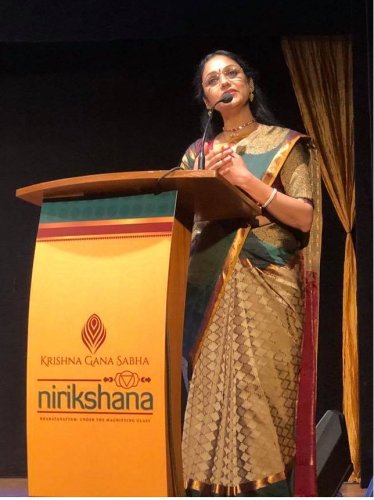 Rama Vaidyanathan Rama Vaidyanathan has to be commended on pulling off an event with panache. She has succeeded in bringing the young back to watching dance. While inspired by the success, the less successful areas can be a pointer for next year's Natya Kala Conference.  Writing on the dance scene for the last forty years, Leela Venkataraman's incisive comments on performances of all dance forms, participation in dance discussions both in India and abroad, and as a regular contributor to Hindu Friday Review, journals like Sruti and Nartanam, makes her voice respected for its balanced critiquing. She is the author of several books like Indian Classical dance: Tradition in Transition, Classical Dance in India and Indian Classical dance: The Renaissance and Beyond. Post your comments Please provide your name and email id when you use the Anonymous profile in the blog to post a comment. All appropriate comments posted with name and email id in the blog will also be featured in the site. |